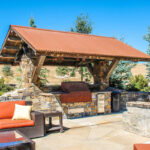Metal panels have unbelievable strength and high-performing characteristics, but you may be curious as to how a metal roof or metal siding will perform in your specific environment. Whether you live in the rugged mountains or dry desert, we’re breaking down exactly how metal will perform in your climate.
Wet, High Precipitation Climates

A leaking roof is a homeowner’s worst nightmare. Whether you have to replace or simply repair a leaking roof, it’s going to cost you time and money. If you live in an area that experiences high amounts of precipitation, metal can be one of the best roofing solutions for you. Metal panels shed water like a pro, and don’t retain any moisture.
Many metal panels for roofing are equipped with anti-siphon grooves. These grooves, formed into a panel’s edge, create a break in the panels, preventing the “suction” effect that usually transfers fluid between materials.
High Wind Environments
Although wind can be random, some areas are prone to wind more often than others. If you live in an area with frequent wind, or high-speed winds, roofing can be tricky. Shingles and other materials may lift, but metal roofs offer a structurally sound solution that hold up well in windy conditions.
When it comes to choosing the type of panel, whether it’s exposed or concealed fastener, can also affect a roof’s performance in high speed wind areas. Hidden fastener panels provide a more rigid connection to a home’s substrate. However, depending on the clip system needed to secure the panels, it may restrict your roof’s movement against other types of weather. Exposed fastener roofing systems secured over solid substrate offer excellent protection against wind.
Heavy Snow Load Environments

Heavy amounts of snow over a short period of time can cause extra stress on your roof. One of the biggest concerns with heavy snow loads on a roof is protecting a home’s moisture barrier. As snow slightly melts, it will refreeze on your roof before sliding off. While this happens, it’s crucial your roof is able to maintain its moisture barrier.
Metal roofs are designed to hold and withstand heavy snow loads. Metal roof panels equipped with anti-siphon grooves show superior weather tightness and protection against water intrusion or snow melt. Metal panels are also significantly lighter weight than asphalt shingles, so the added extra weight of snow doesn’t add as much extra stress on your home.
Hail Prone Environments

Hail damage to a roof is no joke. It can be detrimental to your entire roofing system, and your budget. While no roof is 100% hail-proof, metal panels come pretty close in terms of hail resistance. Thicker gauge metal panels, such as 26 gauge, are typically recommended for better resistance to punctures from hailstones. A thicker gauge also means stronger seams between panels.
Another factor that can help protect your roof from damage is the tensile strength of the panels. Tensile strength refers to the resistance of a material to breaking under tension. A higher tensile strength means your metal roof will hold up better to dents and other types of surface damage compared to a lowed tensile strength. Although, when it comes to steel, a lower tensile strength doesn’t necessarily mean your roof will be punctured, rather, it will just deform or even slightly stretch.
One of the last factors to consider for hail-prone areas is the type of metal panel profile for your roof. Corrugated panels have a naturally wavy design that can help easily hide imperfections and even deflect hail.
Extreme Temperature Fluctuation Environments
A lot of areas experience extreme temperature fluctuations. The mornings and evenings can be frigid, while temperatures quickly rise during the afternoon. Many materials struggle to adapt with these fluctuations — shingles are likely to crack or warp. Metal, on the other hand, is actually designed to flex and adapt with changing temperatures, and withstand cracking or warping from that.
A panel’s ability to expand and contract with changing temperatures lies in its clip system. Clip, used in most concealed fastener panels, come in fixed, floating, and slider varieties. Both slider and floating clips are ideal for areas with dramatic temperature shifts, allowing for thermal movement. Floating clips are able to “float” and allow for expansion and contraction. Overall, metal is a great choice for those living in areas prone to dramatic temperature swings.












